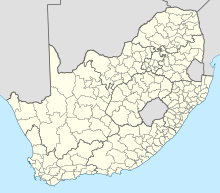Municipalities of South Africa
Local government in South Africa consists of municipalities (Tswana: bommasepala; Sotho: bomasepala; Northern Sotho: bommasepala; Afrikaans: munisipaliteite; Zulu: ngomasipala; Southern Ndebele: bomasipala; Xhosa: ngoomasipala; Swazi: bomasipala; Venda: vhomasipala; Tsonga: vamasipala) of various types. The largest metropolitan areas are governed by metropolitan municipalities, while the rest of the country[1] is divided into district municipalities, each of which consists of several local municipalities. Since the boundary reform at the time of the municipal election of 3 August 2016 there are eight metropolitan municipalities, 44 district municipalities and 205 local municipalities.[2]
 |
|---|
| This article is part of a series on the politics and government of South Africa |
|
|
|
Related topics |
|
|

Categories
Municipalities can belong to one of three categories: metropolitan, district and local (referred to in the constitution as categories A, B and C).
Metropolitan municipalities
Metropolitan (or category A) municipalities govern large densely urbanised regions that encompass multiple centers with close economic linkages, i.e. metropolises. Metropolitan municipalities are unitary authorities responsible for all local government functions within their areas.
Since the 2011 municipal election there are eight metropolitan municipalities:
- Buffalo City (East London – Mdantsane – Zwelitsha – King William's Town – Bhisho)
- City of Cape Town (Cape Town – Bellville – Mitchells Plain – Khayelitsha – Somerset West – Simon's Town)
- City of Johannesburg (Johannesburg – Soweto – Lenasia – Randburg – Sandton – Midrand)
- City of Tshwane (Pretoria – Centurion – Soshanguve – Hammanskraal – Mamelodi – Bronkhorstspruit)
- Ekurhuleni (Alberton – Katlehong – Germiston – Kempton Park – Tembisa – Boksburg – Benoni – Brakpan – Springs – Daveyton – Nigel)
- eThekwini (Durban – Umhlanga – Phoenix – KwaMashu – Pinetown – Chatsworth – Umlazi – Amanzimtoti)
- Mangaung (Bloemfontein – Botshabelo – Thaba 'Nchu)
- Nelson Mandela Bay (Port Elizabeth – iBhayi – Despatch – Uitenhage)
Buffalo City and Mangaung were originally local municipalities (see below) which were separated from their district municipalities and upgraded to metropolitan status in 2011. The other six municipalities were founded as metropolitan municipalities at the inception of the current system of local government in 2000.
District and local municipalities
The rest of the country, outside the metropolitan areas, is governed jointly by district and local municipalities. Each district (or category C) municipality is divided into a number of local (category B) municipalities. District municipalities have responsibility for broader matters such as integrated planning, infrastructure development, bulk supply of water and electricity, and public transport; while local municipalities have responsibility for all municipal functions not assigned to the district, and in particular local service delivery. As of 2016 there are 44 district municipalities divided into 205 local municipalities.
Elections
Municipalities are governed by municipal councils which are elected every five years. The most recent nationwide election of municipal councils was held on 3 August 2016.
The councils of metropolitan and local municipalities are elected by a system of mixed-member proportional representation. These municipalities are divided into wards, and each ward directly elects one councillor by first-past-the-post voting. An equal number of councillors are appointed from party lists so that the overall makeup of the council is proportional to the votes received by each party.
In district municipalities, 60% of the councillors are appointed by the councils of their constituent local municipalities, while the remaining 40% are elected by party-list proportional representation.[3]
Legislation
The basic structure of local government originates from Chapter 7 of the Constitution of South Africa. In addition to this a number of acts of Parliament regulate the organisation of local government. The principal statutes are:
- Local Government: Municipal Demarcation Act, 1998 (Act 27 of 1998)
- Local Government: Municipal Structures Act, 1998 (Act 117 of 1998)
- Local Government: Municipal Systems Act, 2000 (Act 32 of 2000)
- Local Government: Municipal Finance Management Act, 2003 (Act 56 of 2003)
- Local Government: Municipal Property Rates Act, 2004 (Act 6 of 2004)
Name changes
The South African Geographical Names Council is a statutory body that deals specifically with changing names of places in South Africa, including municipalities.
Notes and references
- With the exception of the Prince Edward Islands, although they are for certain legal purposes deemed to fall within the City of Cape Town.
- "Electoral Commission on 2016 municipal elections" (Press release). Electoral Commission. 8 June 2016. Retrieved 21 January 2017.
- "Understanding Local Government". Community Organisers Toolbox. Education and Training Unit. Retrieved 24 May 2012.
See also
External links
- South African Local Government Association Home Page
- Chapter 7 of the Constitution of South Africa This chapter describes the municipal government structure in the country.